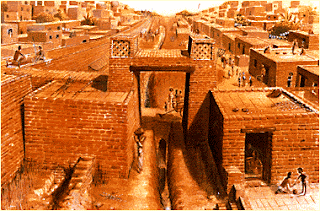
Small triangular opening may have served as air ducts to allow the flow of fresh air beneath the hollow floors. A wooden superstructure supported in some places by large columns would have been built on top of the brick foundations, with stairs leading up from the central passage area. Altogether there were twelve units arranged in blocks of six each. It is a brick structure built on a massive brick foundation over 45 metres north-south and 45 metres east-west. The granaries stood on a core of mud platform. The presence of these structures do provide a glimpse, howsoever hazy, of the surplus wealth at the disposal of the authority in the Indus Valley Civilisation. In fact the whole period of the Harappan Civilazation is divided into three distinct phases: (i) Early Harappan Phase (3500BC 1900 BC) It was distinguished by.

By the middle of the 3rd millenium BCE, we see a fairly developed urban culture along the Indus and. The prosperity of the Harappan Civilization, that was discovered in 1920-22 when two of its most important sites were excavated, was based on its flourishing economic activities such as agriculture, arts and crafts, and trade. The archaeological excavations, both at Harappan and Mohenjo-daro have revealed very large structures, which are interpreted to be large food grain storage buildings and are referred to as the Granaries. Historical Beginnings: The Indus Valley Civilisation. It is called Harappa because this civilization was first discovered in 1921 at the modern site of Harappa situated in the West Punjab (Pakistan).

its great granaries for preserving grains (Indus people cultivated variety of crops like wheat, barley, rice, different pulses, musk melons, date palms and most notably cotton – cotton was first cultivated in India and Indus people exported cotton garments to the middle east). THE HARAPPAN CIVILIZATION (C.3300-1300 BCE) Harappan Civilization is a synonym for Indus Valley Civilization, which arose in the northwestern part of the Indian subcontinent.


 0 kommentar(er)
0 kommentar(er)
